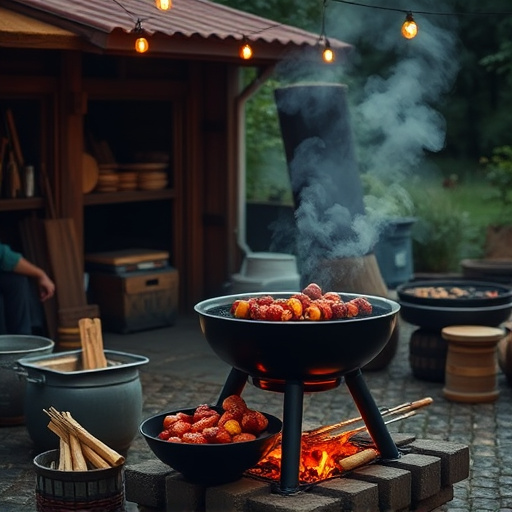Selecting the ideal cut of ribs is key to crafting a perfect BBQ rib recipe grill experience. Choose between baby back or St. Louis-style ribs based on desired flavor and texture. Understand rib anatomy for even cooking and trim silver skin for better marinade penetration. Prepare ribs with dry or wet rubs, allowing flavors to develop over time. Cook slowly over indirect heat for tender, juicy results, nesting ribs over coals for smoke flavor.
Unleash your inner BBQ master with our simple guide to perfect rib technique. From choosing the right cut – be it tender baby back or meaty St. Louis style – to mastering the art of smoking low and slow, we’ve got you covered. Learn about dry vs wet rubs, ideal temperature ranges, and the best wood for smoke flavor. Discover direct and indirect heat methods, effective basting techniques, and the secret to a crispy crust. Finally, rest your ribs properly for maximum tenderness before slicing and serving. Elevate your BBQ rib recipe game with these essential tips!
- Choosing the Right Ribs: Select Your Cut
- – Types of BBQ ribs: Baby back vs. St. Louis cut
- – Understanding rib muscle and fat content
- Preparation is Key: Getting Your Ribs Ready
- – Dry rub or wet rub?
- – How to season ribs for maximum flavor
Choosing the Right Ribs: Select Your Cut
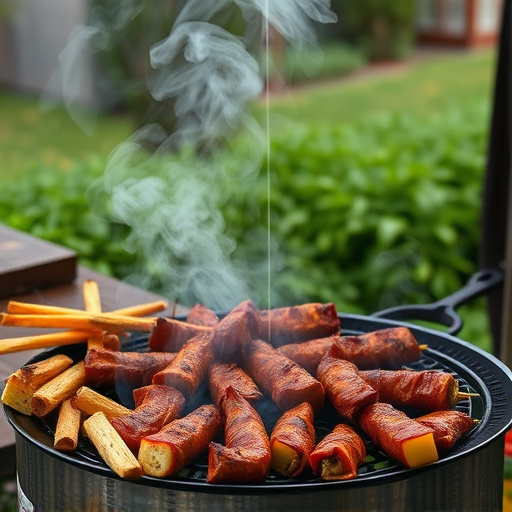
When it comes to perfect BBQ ribs, choosing the right cut is half the battle won. Opt for baby back ribs or spare ribs – both are popular choices due to their balance between meat and bone. Baby back ribs have a smaller bone structure, making them easier to handle on the grill, while spare ribs offer a more substantial, meaty experience. Look for ribs with good marbling, indicating flavor-packed fat distribution, and aim for a consistent thickness for even cooking. A quality BBQ rib recipe starts with the right cut, ensuring your final dish is tender, juicy, and full of that smoky, mouthwatering flavor.
Consider buying whole slabs instead of pre-cut ribs to have more control over the cooking process. This allows you to achieve that sought-after crispy exterior while keeping the interior perfectly tender – the hallmark of a perfect BBQ rib. The cut you choose will also influence your preferred cooking method and seasoning, so understanding these nuances is key to mastering your BBQ rib grill technique.
– Types of BBQ ribs: Baby back vs. St. Louis cut

BBQ ribs are a classic grill favorite, but with two primary cuts available, choosing the right one for your perfect BBQ rib recipe can be daunting. The most common types are baby back and St. Louis cut, each offering distinct advantages and flavors. Baby back ribs, as the name suggests, come from the baby back section of the pig, just behind the loin. They have a milder flavor profile and tend to be leaner with less marbling, making them easier to cook evenly on the grill. This cut is ideal for those who prefer a lighter BBQ rib recipe, allowing the natural sweetness of the pork to shine through without overwhelming flavors from heavier marinades or sauces.
In contrast, St. Louis-style ribs, also known as “full” or “spare” ribs, come from the belly section of the pig and are attached at both ends to a bone. These ribs are meaty and rich, offering a robust flavor that pairs well with hearty BBQ sauces. Due to their thicker cut and higher fat content, St. Louis ribs require longer cooking times and can be more challenging to grill perfectly, but they’re a favorite among those who love a juicy, flavorful rib recipe that melts in your mouth.
– Understanding rib muscle and fat content
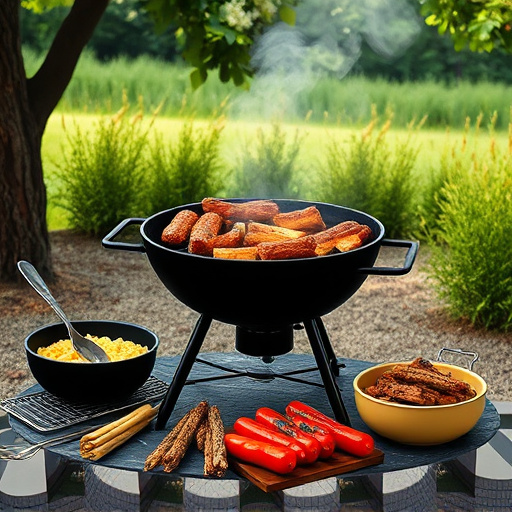
Understanding the anatomy of a rib is key to achieving perfect BBQ rib recipe results on your grill. Each rib is composed of muscle, fat, and bone, with the ideal ratio varying depending on the cut. The meatiest part, known as the “meat cap” or “rib meat,” should be well-marbled with fat, providing both moisture and flavor during slow-cooking. This fat content is crucial for preventing dryness, especially when cooking low and slow over indirect heat.
When selecting your BBQ rib recipe, consider cuts like baby back ribs or St. Louis-style ribs, which offer a balance of muscle and fat. Properly trimming the ribs, removing any silver skin (a thin layer of membrane), will ensure even cooking and allow the flavorful marinade or rub to penetrate better. This simple step can significantly impact the overall quality and taste of your grilled ribs.
Preparation is Key: Getting Your Ribs Ready
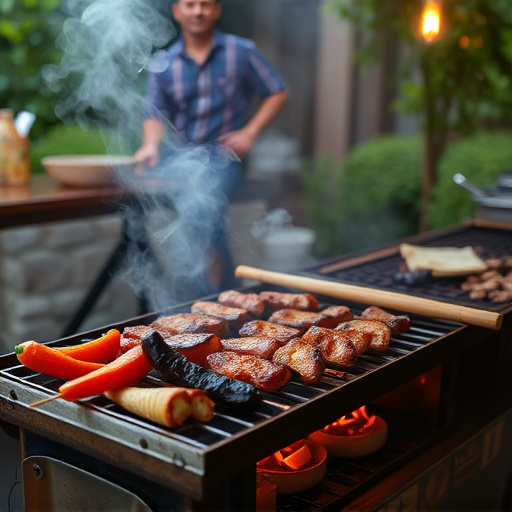
Preparation is the cornerstone of any successful BBQ rib venture. Start by selecting the perfect cut – baby back or spare ribs work best for grilling. Next, trim off any excess fat to allow even cooking and a crispier crackling skin. A good BBQ rib recipe involves marinating the meat in a mixture of your favorite spices, usually including salt, pepper, paprika, garlic powder, and onion powder. This step enhances flavor and tenderizes the ribs, ensuring they’re juicy and delicious when cooked.
For optimal results, prepare your ribs at least an hour before grilling to allow the flavors to penetrate. Wrap them tightly in plastic wrap or foil if you plan to cook them low and slow, or simply pat them dry and rub on some BBQ sauce for a quicker, higher-heat approach. Getting your ribs ready ahead of time ensures they’ll be the centerpiece of any gathering, with tender, succulent meat that melts in your mouth.
– Dry rub or wet rub?

When it comes to grilling perfect BBQ ribs, one of the most debated topics is whether to use a dry rub or a wet rub. Both have their advocates and offer distinct flavors, but for a beginner, starting with a simple dry rub is often recommended. Dry rubs are essentially spice blends that coat the ribs directly, allowing each individual spice to enhance the meat’s natural flavor without any added moisture. This method lets the heat from the grill do its job, slowly cooking and tenderizing the ribs while the spices penetrate the meat.
On the other hand, wet rubs incorporate ingredients like vinegar, olive oil, or melted butter, creating a marinade that not only adds moisture but also delivers a burst of flavor. Wet rubs are ideal for quicker cooking times and can be particularly effective when using a lower heat setting on your grill. However, they may require more attention to ensure even cooking and prevent the ribs from becoming too soggy. For a balanced approach, consider a hybrid method where you apply a dry rub before grilling and baste the ribs with a simple wet sauce during the last few hours of cook time for that classic BBQ rib recipe grill experience.
– How to season ribs for maximum flavor
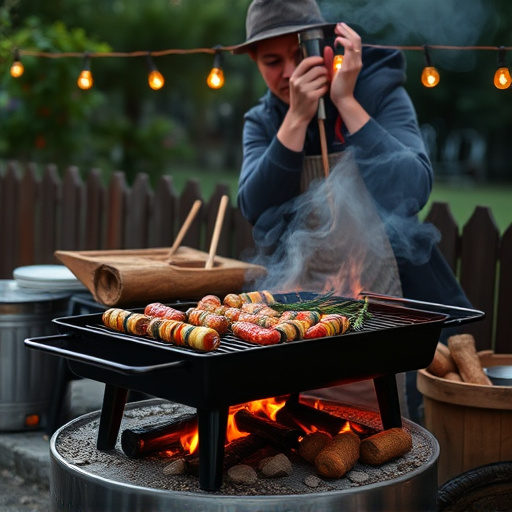
To achieve mouthwatering, perfectly seasoned BBQ ribs, start by rubbing your ribs with a generous amount of dry rub. A classic blend includes spices like paprika, brown sugar, garlic powder, salt, and pepper. Massaging the dry rub into the meat ensures even distribution for maximum flavor. Let the ribs sit at room temperature for an hour to allow the spices to penetrate the meat. For extra tenderness, consider adding a wet rub or marinating the ribs in your favorite BBQ sauce before cooking; this step will help break down the collagen and make your ribs fall-off-the-bone tender.
Once seasoned, preheat your grill to achieve indirect heat, which is crucial for slow-cooking ribs until they’re tender. This method allows you to control the temperature, ensuring the ribs cook evenly and retain their moisture. During cooking, avoid direct contact with high heat; instead, keep them nestled over a bed of coals or chunks of hardwood for a smoky flavor that elevates your BBQ rib recipe.
